

In the list of properties of the Fourier transform, we defined the convolution of two functions, \(f(x)\) and \(g(x)\) to be the integral \[(f * g)(x)=\int_<-\infty>^ <\infty>f(t) g(x-t) d t .\label \] In some sense one is looking at a sum of the overlaps of one of the functions and all of the shifted versions of the other function. The German word for convolution is faltung, which means "folding" and in old texts this is referred to as the Faltung Theorem. In this section we will look into the convolution operation and its Fourier transform. Before we get too involved with the convolution operation, it should be noted that there are really two things you need to take away from this discussion. The rest is detail. First, the convolution of two functions is a new functions as defined by \(\eqref\) when dealing wit the Fourier transform. The second and most relevant is that the Fourier transform of the convolution of two functions is the product of the transforms of each function. The rest is all about the use and consequences of these two statements. In this section we will show how the convolution works and how it is useful.
First, we note that the convolution is commutative: \(f * g=g * f\) . This is easily shown by replacing \(x-t\) with a new variable, \(y=x-t\) and \(d y=-d t\) . \[\begin
In order to understand the convolution operation, we need to apply it to specific functions. We will first do this graphically for the box function \[f(x)=\left\1,&|x|\leq 1, \\ 0,&|x|>1\end\right.\nonumber \] and the triangular function \[g(x)=\left\x,&0\leq x\leq 1, \\ 0,&\text\end\right.\nonumber \] as shown in Figure \(\PageIndex\). 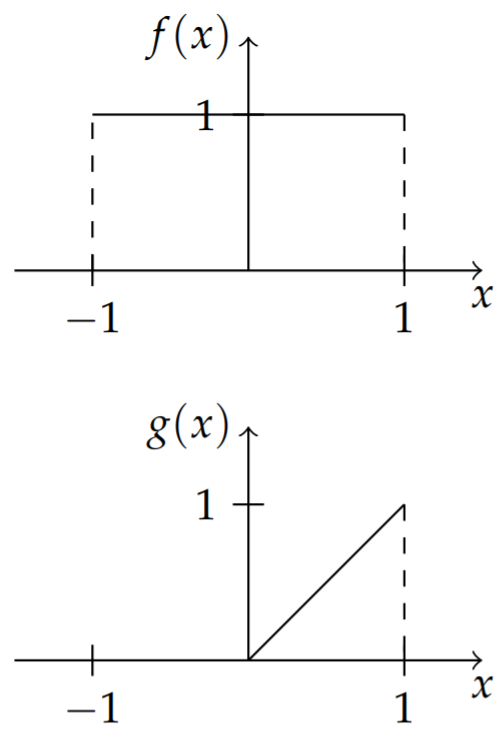 Next, we determine the contributions to the integrand. We consider the shifted and reflected function \(g(t-x)\) in Equation \(\eqref\) for various values of \(t\) . For \(t=0\) , we have \(g(x-0)=g(-x)\) . This function is a reflection of the triangle function, \(g(x)\) , as shown in Figure \(\PageIndex\).
Next, we determine the contributions to the integrand. We consider the shifted and reflected function \(g(t-x)\) in Equation \(\eqref\) for various values of \(t\) . For \(t=0\) , we have \(g(x-0)=g(-x)\) . This function is a reflection of the triangle function, \(g(x)\) , as shown in Figure \(\PageIndex\). 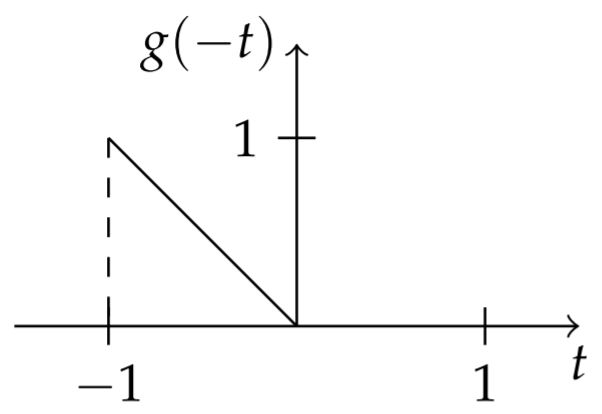 We then translate the triangle function performing horizontal shifts by \(t\) . In Figure \(\PageIndex\) we show such a shifted and reflected \(g(x)\) for \(t=2\) , or \(g(2-x)\) .
We then translate the triangle function performing horizontal shifts by \(t\) . In Figure \(\PageIndex\) we show such a shifted and reflected \(g(x)\) for \(t=2\) , or \(g(2-x)\) . 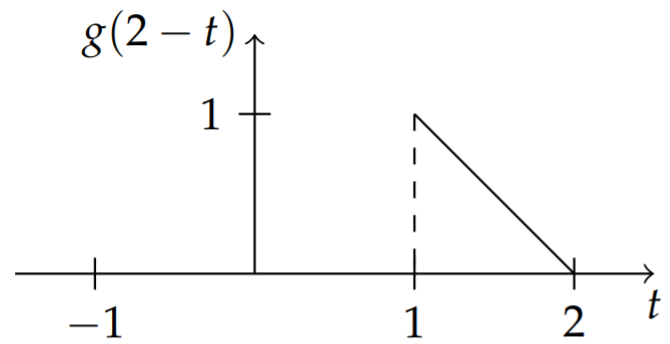 In Figure \(\PageIndex\) we show several plots of other shifts, \(g(x-t)\) , superimposed on \(f(x)\) . The integrand is the product of \(f(t)\) and \(g(x-t)\) and the integral of the product \(f(t) g(x-t)\) is given by the sum of the shaded areas for each value of \(x\) . In the first plot of Figure \(\PageIndex\) the area is zero, as there is no overlap of the functions. Intermediate shift values are displayed in the other plots in Figure \(\PageIndex\). The value of the convolution at \(x\) is shown by the area under the product of the two functions for each value of \(x\) .
In Figure \(\PageIndex\) we show several plots of other shifts, \(g(x-t)\) , superimposed on \(f(x)\) . The integrand is the product of \(f(t)\) and \(g(x-t)\) and the integral of the product \(f(t) g(x-t)\) is given by the sum of the shaded areas for each value of \(x\) . In the first plot of Figure \(\PageIndex\) the area is zero, as there is no overlap of the functions. Intermediate shift values are displayed in the other plots in Figure \(\PageIndex\). The value of the convolution at \(x\) is shown by the area under the product of the two functions for each value of \(x\) . 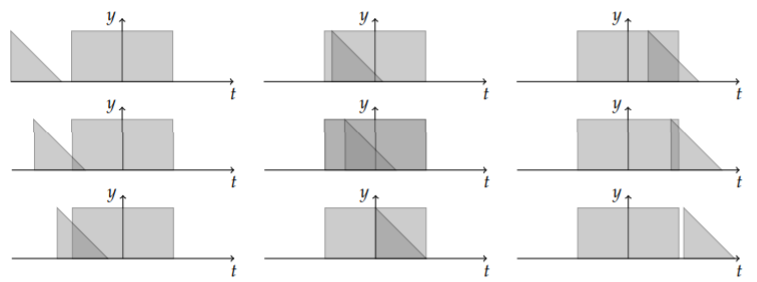 Plots of the areas of the convolution of the box and triangle functions for several values of \(x\) are given in Figure \(\PageIndex\). We see that the value of the convolution integral builds up and then quickly drops to zero as a function of \(x\). In Figure \(\PageIndex\) the values of these areas is shown as a function of \(x\).
Plots of the areas of the convolution of the box and triangle functions for several values of \(x\) are given in Figure \(\PageIndex\). We see that the value of the convolution integral builds up and then quickly drops to zero as a function of \(x\). In Figure \(\PageIndex\) the values of these areas is shown as a function of \(x\). 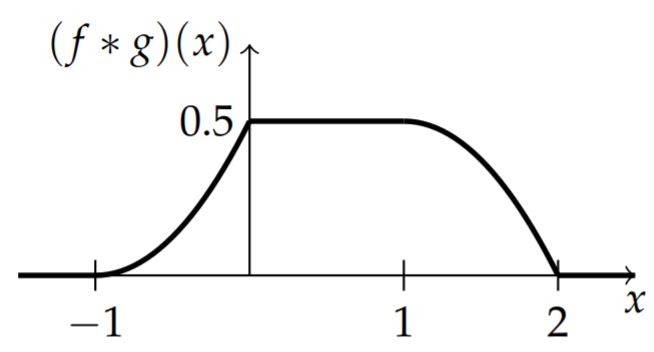
The plot of the convolution in Figure \(\PageIndex<5>\) is not easily determined using the graphical method. However, we can directly compute the convolution as shown in the next example.
The nonvanishing contributions to the convolution integral are when both \(f(t)\) and \(g(x-t)\) do not vanish. \(f(t)\) is nonzero for \(|t| \leq 1\) , or \(-1 \leq t \leq 1 . g(x-t)\) is nonzero for \(0 \leq x-t \leq 1\) , or \(x-1 \leq t \leq x\) . These two regions are shown in Figure \(\PageIndex<6>\). On this region, \(f(t) g(x-t)=x-t\) . 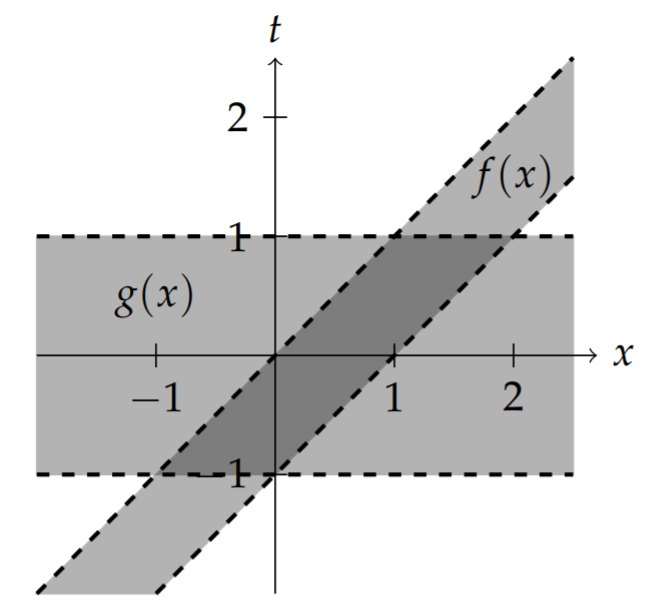 Isolating the intersection in Figure \(\PageIndex\), we see in Figure \(\PageIndex\) that there are three regions as shown by different shadings. These regions lead to a piecewise defined function with three different branches of nonzero values for \(-1 The values of the convolution can be determined through careful integration. The resulting integrals are given as \[\begin (f\ast g)(x)&=\int_<-\infty>^\infty f(t)g(x-t)dt\nonumber \\ &=\left\\int_^x (x-t)dt, &-1^x (x-t)dt, &0^1(x-t)dt,&1\right.\nonumber \\ &=\left\\frac(x+1)^2,&-1
Isolating the intersection in Figure \(\PageIndex\), we see in Figure \(\PageIndex\) that there are three regions as shown by different shadings. These regions lead to a piecewise defined function with three different branches of nonzero values for \(-1 The values of the convolution can be determined through careful integration. The resulting integrals are given as \[\begin (f\ast g)(x)&=\int_<-\infty>^\infty f(t)g(x-t)dt\nonumber \\ &=\left\\int_^x (x-t)dt, &-1^x (x-t)dt, &0^1(x-t)dt,&1\right.\nonumber \\ &=\left\\frac(x+1)^2,&-1
In this section we compute the Fourier transform of the convolution integral and show that the Fourier transform of the convolution is the product of the transforms of each function, \[F[f * g]=\hat

Let \(\hat
Find the convolution of the box function of height one and width two with itself using a direct computation of the convolution integral.
The nonvanishing contributions to the convolution integral are when both \(f(t)\) and \(f(x-t)\) do not vanish. \(f(t)\) is nonzero for \(|t| \leq 1\) , or \(-1 \leq t \leq 1 . f(x-t)\) is nonzero for \(|x-t| \leq 1\) , or \(x-1 \leq t \leq x+1\) . These two regions are shown in Figure \(\PageIndex<10>\). On this region, \(f(t) g(x-t)=1\) . 
 Thus, the nonzero contributions to the convolution are \[(f * f)(x)=\left\ \int_^ d t, \quad 0 \leq x \leq 2, \\ \int_^ d t, \quad-2 \leq x \leq 0, \end=\left\ 2+x, & 0 \leq x \leq 2, \\ 2-x, & -2 \leq x \leq 0 . \end\right.\right.\nonumber \] Once again, we arrive at the triangle function.
Thus, the nonzero contributions to the convolution are \[(f * f)(x)=\left\ \int_^ d t, \quad 0 \leq x \leq 2, \\ \int_^ d t, \quad-2 \leq x \leq 0, \end=\left\ 2+x, & 0 \leq x \leq 2, \\ 2-x, & -2 \leq x \leq 0 . \end\right.\right.\nonumber \] Once again, we arrive at the triangle function.
In the last section we showed the graphical convolution. For completeness, we do the same for this example. In Figure \(\PageIndex<10>\) we show the results. We see that the convolution of two box functions is a triangle function.
In this example we will compute the convolution of two Gaussian functions with different widths. Let \(f(x)=e^<-a x^>\) and \(g(x)=e^>\) . A direct evaluation of the integral would be to compute \[(f * g)(x)=\int_<-\infty>^ <\infty>f(t) g(x-t) d t=\int_<-\infty>^ <\infty>e^<-a t^-b(x-t)^> d t .\nonumber \] This integral can be rewritten as \[(f * g)(x)=e^> \int_<-\infty>^ <\infty>e^<-(a+b) t^+2 b x t> d t .\nonumber \] One could proceed to complete the square and finish carrying out the integration. However, we will use the Convolution Theorem to evaluate the convolution and leave the evaluation of this integral to Problem 12. Recalling the Fourier transform of a Gaussian from Example 9.5.1, we have \[\hat(k)=F[e^]=\sqrt<\frac<\pi>>e^\label \] and \[\hat(k)=F[e^]=\sqrt<\frac<\pi>>e^.\nonumber \] Denoting the convolution function by \(h(x) = (f ∗ g)(x)\), the Convolution Theorem gives \[\hat(k)=\hat(k)\hat(k)=\frac<\pi>>e^e^.\nonumber \] This is another Gaussian function, as seen by rewriting the Fourier transform of \(h(x)\) as \[\hat(k)=\frac<\pi>>e^\left(\frac+\frac\right)k^2>=\frac<\pi>>e^k^2>.\label \] In order to complete the evaluation of the convolution of these two Gaussian functions, we need to find the inverse transform of the Gaussian in Equation \(\eqref\). We can do this by looking at Equation \(\eqref\). We have first that \[F^\left[\sqrt<\frac<\pi>>e^\right]=e^.\nonumber \] Moving the constants, we then obtain \[F^[e^]=\sqrt<\frac<\pi>>e^.\nonumber \] We now make the substitution \(\alpha =\frac\), \[F^[e^]=\sqrt<\frac<4\pi\alpha>>e^.\nonumber \] This is in the form needed to invert \(\eqref\). Thus, for \(\alpha =\frac\) we find \[(f * g)(x)=h(x)=\sqrt<\frac<\pi>> e^ x^> .\nonumber \]
There are many applications of the convolution operation. One of these areas is the study of analog signals. An analog signal is a continuous signal and may contain either a finite, or continuous, set of frequencies. Fourier transforms can be used to represent such signals as a sum over the frequency content of these signals. In this section we will describe how convolutions can be used in studying signal analysis. The first application is filtering. For a given signal there might be some noise in the signal, or some undesirable high frequencies. For example, a device used for recording an analog signal might naturally not be able to record high frequencies. Let \(f(t)\) denote the amplitude of a given analog signal and \(\hat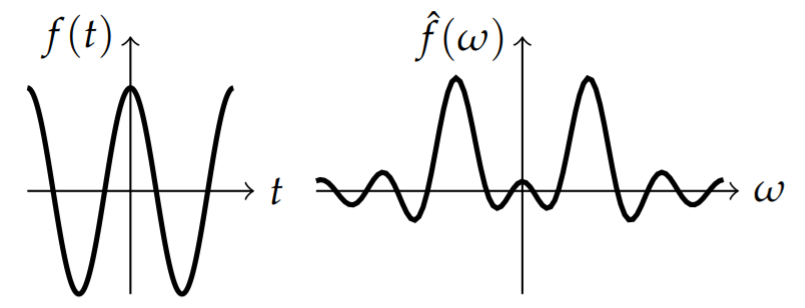 There are many ways to filter out unwanted frequencies. The simplest would be to just drop all of the high (angular) frequencies. For example, for some cutoff frequency \(\omega_\) frequencies \(|\omega|>\omega_\) will be removed. The Fourier transform of the filtered signal would then be zero for \(|\omega|>\omega_\) . This could be accomplished by multiplying the Fourier transform of the signal by a function that vanishes for \(|\omega|>\omega_\) . For example, we could use the gate function \[p_<\omega_>(\omega)=\left\ 1, & |\omega| \leq \omega_ \\ 0, & |\omega|>\omega_ \end,\right.\label \] as shown in Figure \(\PageIndex\).
There are many ways to filter out unwanted frequencies. The simplest would be to just drop all of the high (angular) frequencies. For example, for some cutoff frequency \(\omega_\) frequencies \(|\omega|>\omega_\) will be removed. The Fourier transform of the filtered signal would then be zero for \(|\omega|>\omega_\) . This could be accomplished by multiplying the Fourier transform of the signal by a function that vanishes for \(|\omega|>\omega_\) . For example, we could use the gate function \[p_<\omega_>(\omega)=\left\ 1, & |\omega| \leq \omega_ \\ 0, & |\omega|>\omega_ \end,\right.\label \] as shown in Figure \(\PageIndex\).  In general, we multiply the Fourier transform of the signal by some filtering function \(\hat(t)\) to get the Fourier transform of the filtered signal, \[\hat(\omega)=\hat
In general, we multiply the Fourier transform of the signal by some filtering function \(\hat(t)\) to get the Fourier transform of the filtered signal, \[\hat(\omega)=\hat
We return to the finite wave train in Example 9.5.6 given by \[h(t)=\left\ \cos \omega_ t, & |t| \leq a \\ 0, & |t|>a \end .\right.\nonumber \]
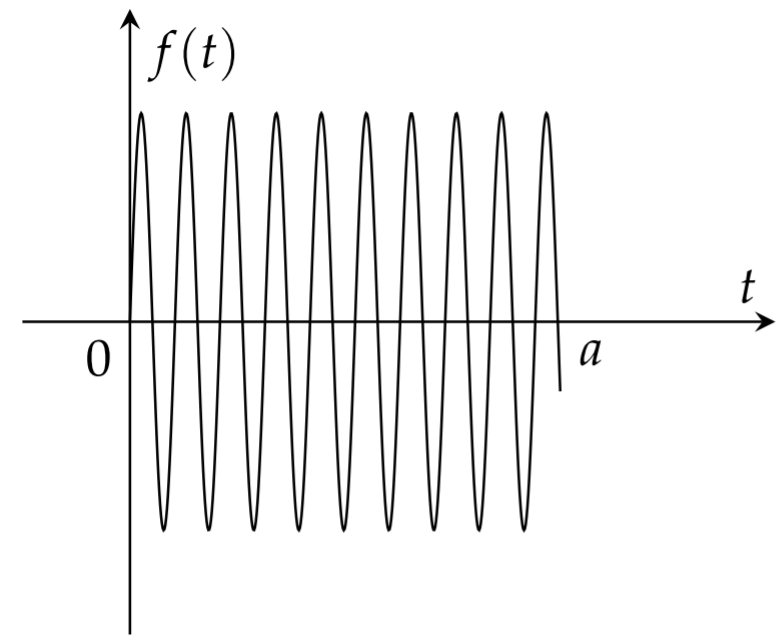
We can view this as a windowed version of \(f(t)=\cos \omega_<0>\) t obtained by multiplying \(f(t)\) by the gate function \[g_a(t)=\left\1,&|x|\leq a \\ 0,&|x|>a\end\right.\label \] This is shown in Figure \(\PageIndex\). Then, the Fourier transform is given as a convolution, \[\begin \hat(\omega) &=\left(\hat * \hat_\right)(\omega)\nonumber \\ &=\frac \int_<-\infty>^ <\infty>\hat(\omega-v) \hat_(v) d v .\label \end \] Note that the convolution in frequency space requires the extra factor of \(1 /(2 \pi)\) .
The convolution in spectral space is defined with an extra factor of \(1 / 2 \pi\) so as to preserve the idea that the inverse Fourier transform of a convolution is the product of the corresponding signals.
We need the Fourier transforms of \(f\) and \(g_\) in order to finish the computation. The Fourier transform of the box function was found in Example 9.5.2 as \[\hat_(\omega)=\frac <\omega>\sin \omega a \text <. >\nonumber \] The Fourier transform of the cosine function, \(f(t)=\cos \omega_ t\) , is \[\begin \hat(\omega) &=\int_<-\infty>^ <\infty>\cos \left(\omega_ t\right) e^ d t\nonumber \\ &=\int_<-\infty>^ <\infty>\frac\left(e^ +e^ <-i \omega_t>\right) e^ d t\nonumber \\ &=\frac \int_<-\infty>^<\infty>\left(e^
The integral/sum of the (modulus) square of a function is the integral/sum of the (modulus) square of the transform.
As another example of the convolution theorem, we derive Parseval’s Equality (named after Marc-Antoine Parseval (1755-1836)): \[\int_<-\infty>^<\infty>|f(t)|^ d t=\frac \int_<-\infty>^<\infty>|\hat(\omega)|^ d \omega .\label \] This equality has a physical meaning for signals. The integral on the left side is a measure of the energy content of the signal in the time domain. The right side provides a measure of the energy content of the transform of the signal. Parseval’s equality, is simply a statement that the energy is invariant under the Fourier transform. Parseval’s equality is a special case of Plancherel’s formula (named after Michel Plancherel, 1885-1967). Let’s rewrite the Convolution Theorem in its inverse form \[F^[\hat(k) \hat(k)]=(f * g)(t) .\label \] Then, by the definition of the inverse Fourier transform, we have \[\int_<-\infty>^ <\infty>f(t-u) g(u) d u=\frac \int_<-\infty>^ <\infty>\hat(\omega) \hat(\omega) e^ d \omega .\nonumber \] Setting \(t=0\) , \[\int_<-\infty>^ <\infty>f(-u) g(u) d u=\frac \int_<-\infty>^ <\infty>\hat(\omega) \hat(\omega) d \omega .\label \] Now, let \(g(t)=\overline\) , or \(f(-t)=\overline\) . We note that the Fourier transform of \(g(t)\) is related to the Fourier transform of \(f(t)\) : \[\begin \hat(\omega) &=\int_<-\infty>^ <\infty>\overline e^ d t\nonumber \\ &=-\int_<\infty>^ <-\infty>\overline> d \tau\nonumber \\ &=\int_<-\infty>^ <\infty>f(\tau) e^ d \tau=\bar(\omega) .\label \end \] So, inserting this result into Equation \(\eqref\), we find that \[\int_<-\infty>^ <\infty>f(-u) \overline d u=\frac \int_<-\infty>^<\infty>|\hat(\omega)|^ d \omega\nonumber \] which yields Parseval’s Equality in the form \(\eqref\) after substituting \(t=-u\) on the left. As noted above, the forms in Equations \(\eqref\) and \(\eqref\) are often referred to as the Plancherel formula or Parseval formula. A more commonly defined Parseval equation is that given for Fourier series. For example, for a function \(f(x)\) defined on \([-\pi, \pi]\) , which has a Fourier series representation, we have \[\frac^>+\sum_^<\infty>\left(a_^+b_^\right)=\frac <\pi>\int_<-\pi>^<\pi>[f(x)]^ d x .\nonumber \] In general, there is a Parseval identity for functions that can be expanded in a complete sets of orthonormal functions, \(\left\<\phi_(x)\right\>, n=1,2, \ldots\) , which is given by \[\sum_^<\infty>
This page titled 9.6: The Convolution Operation is shared under a CC BY-NC-SA 3.0 license and was authored, remixed, and/or curated by Russell Herman via source content that was edited to the style and standards of the LibreTexts platform.